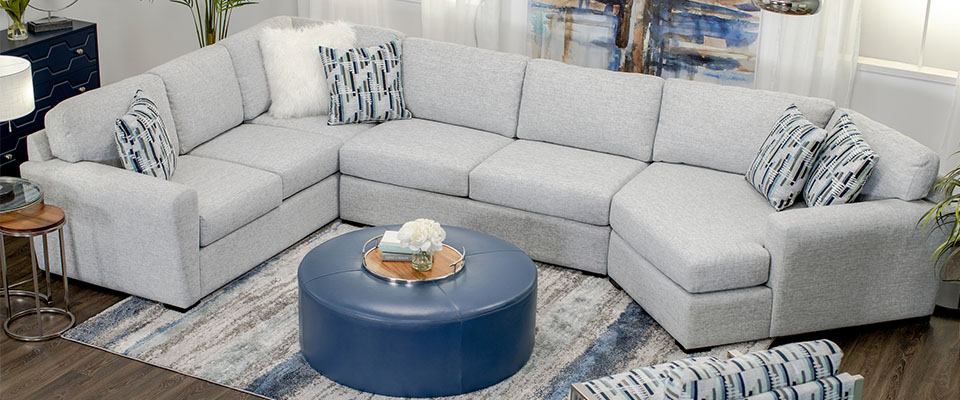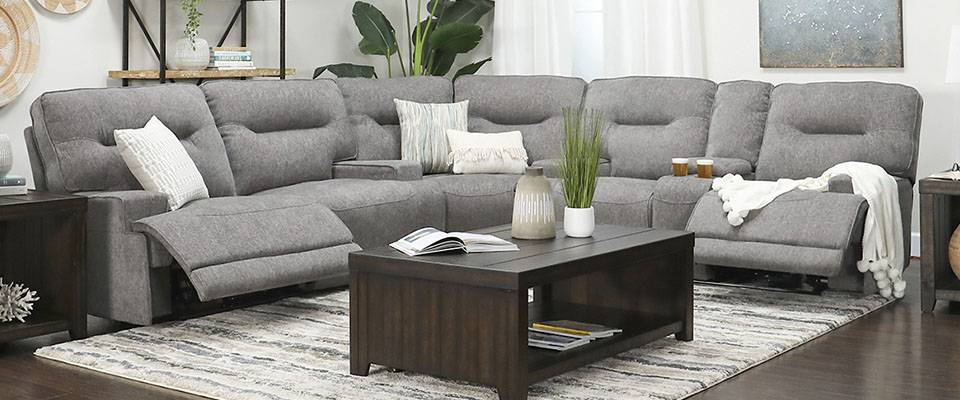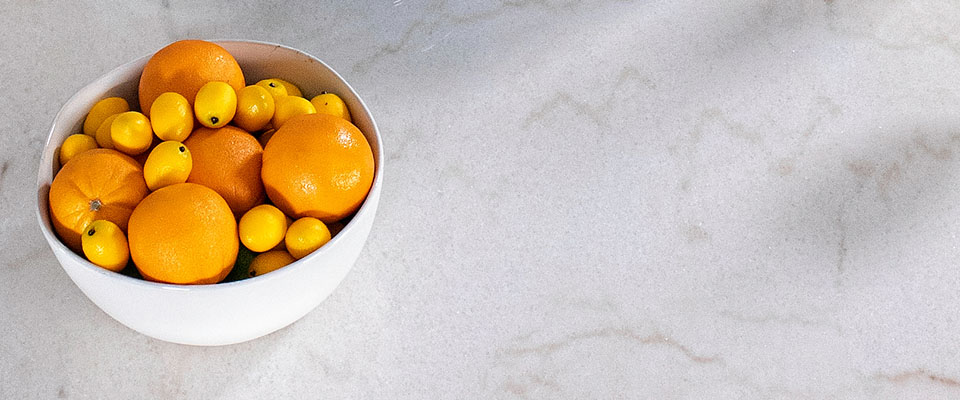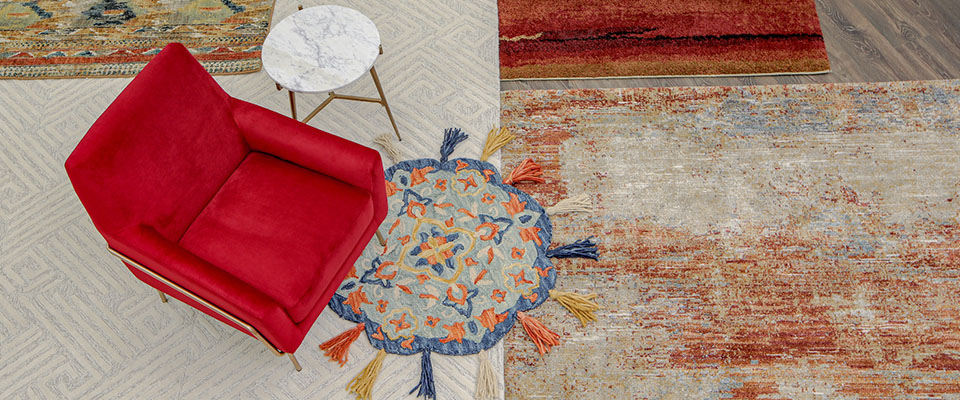Furniture Care Tips
Upholstery care

Routine cleaning of your upholstery
Weekly vacuuming with a soft brush attachment is the single best way to keep your upholstery looking new. It removes tiny dust particles which can be abrasive and can stick to the fabric when you touch them. In addition, vacuuming will reduce potential allergens.
Things to avoid
Direct sunlight will eventually cause fading and damage to any indoor fabric. Be aware of daily sunlight, and make the necessary adjustments. Even when no one is sitting on a sofa, the seat deck is under tremendous pressure from the springs. If you allow walking, jumping, or dropping into a sitting position on your upholstery, that can cause frame damage, requiring a very expensive repair.
Spot cleaning
Blot up fresh spills with tissue or a 100% white cotton rag as soon as possible. If the spill is on a loose cushion, unzip it and place a folded 100% white cotton rag under the spot to collect any moisture that has passed through the fabric. If the spill is a thicker substance, gently scrape it onto tissue with a spoon or the backside of a butter knife.
Before addressing the remaining spot, or older dried up spills, look for product tags with furniture cleaning recommendations. Check our Cleaning Codes guide to see whether you should use a water based cleaner or a commercial solvent cleaner. We recommend that you pre-test your cleaning solution on an inconspicuous location before continuing.
Next, vacuum to remove any dust or loose dirt, and, if you use a water based cleaner, clean with a warm solution of either distilled or purified water and a mild liquid detergent. At Jerome's, we use 1-teaspoon of Dawn® to one gallon of distilled water. If you use a solvent cleaner, follow the directions on the container. Continue cleaning the area with a small, soft brush or a wet rag, but be very gentle so that you do not cause unnecessary wear or change the nap of the fabric. Spot cleaning may cause a residual ring around the wetted area. To help avoid this, use as little liquid as possible to remove the spot while placing an absorbent rag underneath the work area if possible, and remove the moisture with dry absorbent rags quickly with more of a padding motion than a rubbing one. Try to keep your work area as small as possible.
Why 100% cotton and why distilled or purified water?
Conceptually, the goal of removing a stain is to dissolve it into the water and detergent solution, and transfer it away from your upholstery to an absorbent cotton cloth.
White cotton is the most absorbent common fiber; therefore, it's going to absorb the stain away from your upholstery. White cotton is most absorbent when it is dry, warm, prewashed, and composed of fine threads.
Distilled or purified water improves your detergent's cleaning power. Household tap water can contain minerals that can interfere with your detergent's ability to break down stains. Also, tap water can contain chemicals that can leave a residual ring as it dries. Distilled or purified water will lessen the chance of a residual ring around the treated area.
A word on fibers
Upholstery is generally made from two types of fibers: natural and synthetic. Each has its pros and cons when it comes to comfort, appearance and care. The benefits of natural fibers like white cotton and linen are their appearance and softness. They are much more absorbent than synthetic fibers like polyester, olefin, and nylon. Thus, natural fibers will readily absorb stains and can be more difficult to spot clean. Synthetic fibers do not absorb moisture well, they have good stain resistance, and are fairly easy to clean. Many fabrics are woven with more than one type of fiber in order to achieve certain fabric properties. Unfortunately, this makes cleaning more complicated. Understanding the above concepts can be useful in knowing how to care for your upholstery. Take your time and be cautious as to not cause a bigger problem.
Cushion care
Every time someone sits down on a sofa, the weight of their body tends to pull the fabric rearward over the foam core. If you have reversible seat cushions, flipping them over will reverse the process and keep the fabric from shifting too much over time. If possible, rotate the cushions from more heavily used areas to less used areas in order to even out the wear. You can also work the cushions with clean hands to straighten the seams out. Zippers do not indicate that covers may be removed and put in a washing machine for cleaning. Even if you were successful, the clean cushions might not match the remaining body of the sofa. We advise that you call a professional cleaner rather than placing cushion covers in a washing machine.
Leather and vinyl care
Like most true products of nature, leather comes with variations of color and texture. Blemishes, wrinkles, and scars from barbed wire and bug bites are common characteristics that distinguish genuine leather from synthetic materials. They are not considered defects. These natural markings are your assurance that you have real leather, and do not affect its durability.
To remove inconsistencies, factories sometimes "finish" the leather, or apply a coating that covers blemishes and creates a more uniform grain pattern. More finishing makes leather less supple and less enjoyable to the touch. This is why more expensive leather will show more variations. Aficionados of real leather products understand and appreciate this. Leather that has almost zero blemishes, and has very little finishing, is exceptionally rare, and therefore very expensive.
Routine cleaning of your leather and vinyl
The best way to maintain your leather, faux leather or vinyl, including "bonded leather" is to keep it clean, especially where your skin might touch the product. Body oils and cosmetics can sometimes damage leather. Wipe it down with a 100% white cotton cloth that you have dampened with a solution of water and a mild liquid detergent. Make sure the cloth is damp, not saturated or dripping wet. At Jerome's we use a solution of 1-teaspoon of Dawn in 1-gallon of distilled or bottled drinking water. Repeat the procedure with clean water to remove the soap residue, and dry with a clean cotton cloth.
For leather only (not vinyl, faux leather or bonded leather), plan to use a commercial leather conditioner every 6 months, or whenever your leather appears dry or feels dry to the touch. We have had success with Fiebing's saddle soap spray, Lexol cleaner, and Lexol conditioner. After cleaning, apply the conditioner with a damp rag, damp sponge, or your hands. This will replace evaporated oils or oils removed in cleaning, and help keep your leather supple. The process is similar to applying a moisturizer for your own skin. Always test a conditioner in an inconspicuous location first, as sometimes conditioners will darken the existing color, especially while still damp.
Things to avoid for leather and vinyl
Direct sunlight will cause leather and vinyl to fade, dry out, and crack. Dust is a mild abrasive and will cause fine surface scratches. The moisture in our skin has a natural exfoliant that can cause leather and vinyl to harden, crack, or even peel. Body lotion and sweat can cause staining and eventually may cause vinyl and leather to harden and crack. This damage cannot be repaired.
Spot-cleaning leather and vinyl
Blot any spills immediately with tissue or a 100% white cotton rag as thoroughly as possible. Gently apply lather from a mild soap (Neutrogena® or saddle soap) and water (distilled or purified is best) on a slightly dampened cloth or sponge. Repeat with a cloth dampened with fresh water to remove any soap residue, and dry.. For difficult stains, contact a professional cleaning service.
Reclining furniture care

Recliner mechanisms are designed for many years of use, and are typically tested for twenty-five thousand cycles of opening and closing. Despite their durability, they can be bent or broken if the following guidelines aren't followed.
Helpful tips for manual or power recliners
Always sit down gently on the recliner. While sitting upright, engage the reclining mechanism using firm and smooth pressure. When returning manual recliners to the upright position, lean forward using your calves to help retract the footrest while also pushing the handle forward. Make sure that all four legs of your recliner are level and securely touching the floor. Floors tend to be uneven, especially close to walls. Please contact Jerome's Customer Service Department at the first sign of a problem..
Things to avoid
With fully extended arms, the amount of weight that one can lift is greatly reduced. In the same way, a reclining mechanism is at its weakest point when reclined or fully extended and is vulnerable to being damaged or bent. Damaged mechanisms are almost impossible to repair and require a complete swap out of parts. New parts may not always be available. The following tips will help you prevent damaging your reclining mechanism:
- Never allow anyone to climb onto your lap or feet while in the reclined position.
- Never overreach sideways when you are in the reclined position. The tendency here is to push off the footrest.
- Never stand up without first completely closing the mechanism.
- When moving the chair, never grab, hold or pull by the footrest. Carry the chair from the sides of the base.
Lastly, unsupervised children and recliners do not mix. Keep children and their hands away from the interior moving parts.
Power reclining furniture troubleshooting tips
If the power stops working, we recommend the following troubleshooting steps:
- Unplug the power cord from the wall outlet.
- Try plugging another electrical item to test the outlet.
- Make sure all electrical connectors are plugged in correctly.
- Disconnect and reconnect all electrical connections.
- Make sure no wires are cut or frayed, if they are, discontinue use.
- Reconnect the power cord to the wall outlet.
- If the item still doesn't work please contact Jerome's Customer Service Department.
Wood care
Routine wood cleaning instructions
Most wood furniture just needs to be periodically wiped down and free of dust. Avoid using household cleaners that can dull the finish. Dust is somewhat abrasive, so rather than using a dry cloth, it's better to dust wooden surfaces weekly with a damp, 100% white cotton cloth (damp means to saturate with water or a very weak solution of water and dish detergent, and then to wring out thoroughly).
Caring for your wood finish
Caring for your wood furniture depends on the type of finish used. There are two general categories of wood finishes: "Open-grain" finishes are absorbed into the wood grain, like oil and wax; and "closed-grain" finishes that sit on top of the wood grain, such as lacquer.
For open-grained wood finishes, use beeswax formulations such as Howard's® wood products. For closed-grain finishes use a non-silicone, lightweight wax/polish such as those sold in grocery stores. DO NOT OVER-WAX OR OIL. Modern finishes just need to be kept clean, and do not require continual polishing.
Other than routine cleaning with a slightly damp cloth, the only time you would use additional wood care products is if the finish begins to become opaque or cloudy.
Things to avoid
Direct sunlight on wood furniture will eventually cause fading, excessive drying, and will damage the finish. Be aware of daily sunlight, and make the necessary adjustments to protect your furniture. Keep furniture away from heating and air conditioning sources to prevent rapid moisture changes. Do not store liquid products that contain solvents like alcohol on top of your wood furniture. A spill will damage the finish. Use felt backing on lamps and other accessories to prevent scratches. Use placemats under plates and hot pads under serving dishes. Use coasters under all beverages. DO NOT use abrasive or harsh chemicals on wood furniture such as Windex® or counter spray.
Dining tables and chair care
Chair and table leg maintenance instructions
It's important to inspect your chairs and table legs annually, or as soon as you notice any loose joints. As chairs and tables experience changes in heat and humidity throughout the seasons, the wood parts expand and contract at different rates. This can slowly loosen screws and bolts over time, and the joints will begin to flex. When this happens, the hardware will loosen even more quickly, and further use can damage the chair or table leg. If you allow this condition to persist, the table or chair might collapse, resulting in possible injury. Proper maintenance will further the life of your furniture, and thus your enjoyment.
Tightening the chair fasteners:
First, place your chair on a blanket or equivalent over the end of a table (not over a leaf) so you will not scratch anything. Most fasteners require a 4 or 5-millimeter hex wrench; and/or, a 10 or 12-millimeter box wrench. We attach these tools to the bottom of every other chair upon assembly. If you need tools, find your invoice, and contact Jerome's Customer Service Department. With your model numbers, we can mail you the correct tools at no charge.
If legs are rather loose, tighten the fasteners until they just start to give resistance. Put the chair on a level floor and sit in it to seat the legs evenly.Then, finish tightening them.
Please do this with a hand tool, not an electric drill, so that you have fine control over the tightness of the fasteners. Tighten them until just snug. This is not a strength contest. Do not over-tighten, as you can cause damage.
Return the chairs to the floor to check for any movement. If they are solid, you are finished. Remember, "a stitch in time saves 9", so please be aware of the condition of your chairs, and act promptly.
Most importantly, leaning backward or forward is the fastest way to damage your chair. Never allow a guest or a child to do this. In addition, the chair could tip over.
Tables
With a crescent or box wrench, sit under the table, and take a little weight off the leg with your shoulder so that it is free to move in its mount. Tighten only a quarter of a turn past snug. Proper maintenance will further the life of your furniture, and thus your enjoyment.
If you have any questions, please contact Jerome's Customer Service Department.
Things to avoid
With extension tables, it is important to ensure that residual moisture does not remain in the seams of the table top after use or cleaning. Prolonged moisture exposure will cause wood to swell, and will lift the finish. Do not leave unbreathable plastic coverings on wood dining tables for prolonged periods. Plastic will trap moisture (even moisture from humidity) and damage the wood. Never leave standing water, glasses containing chilled liquids or hot containers on the table. This kind of neglect can cause moisture rings, swelling, veneer lifting, finish checking, or crazing. Your table is not guaranteed against moisture damage due to neglect.
Replacing or removing table leaves
Inserting and removing the leaves of a table requires two people-one at each end. When inserting a leaf, place the leaf over the exposed table runners so that the pins and holes match up correctly. In addition, use the wood's grain pattern to properly arrange the leaves. Occasionally, the bottom of the table will have chalk lines and numbers that indicate the correct order. Then from both ends of the table, gently push the table together. If the table is sitting on carpet, lift while gently pushing to reduce the stress on the leg joints. If you are moving a table a short distance by yourself, and do not have help available, drag rather than push so that the legs do not buckle.
Prevent tip over accidents; attach furniture to the wall
Under certain conditions, a chest with all its drawers open can fall forward. Imagine a small child climbing a tall bookcase because a desired toy sits on a high shelf. This is a very dangerous situation and it is therefore extremely important to anchor any piece of furniture or item to your wall so that it cannot tip over on a climbing child. Even if you don't have small children, you may have a small visitor who can quickly get into trouble. The thing about accidents is that they usually happen without warning and in a blink of an eye. According to the US Consumer Product Safety Commission, an average of about 11,000 children per year visit hospital emergency rooms for tip-over related injuries, with about 500 of those resulting in death. This is a project that you don't want to delay. It's not that difficult, and we have some tips for you that will help.
General tips to improve safety
- Place TVs on a sturdy base and push the TV back as far as possible, particularly if anchoring is not possible
- Avoid displaying or storing items on top of furniture such as toys or remote controls that will tempt kids to climb up to get them
- Store heavier items on lower shelves or in lower drawers. Generally, you want to keep the center of gravity of any item as low to the floor as possible
- Get in the habit of keeping all drawers in the closed position and train your children to do the same
- Remember to keep TV and cable cords out of the reach of children
Many products come with wall anchor products. They are also available at hardware stores and online under "furniture safety straps," "anti-tip," and "furniture wall anchors." Generally, the task is to tether your furniture to a wall stud (vertical 2" x 4" wood framing, 16" apart) so that it cannot tip.
Watch this helpful video on how to properly secure furniture to the wall for detailed instructions.
Mattress care
Helpful mattress care tips
Let your new mattress air out. New product odor will dissipate with time. To help speed up the process you can air out your mattress prior to putting on your sheets.
A new mattress needs a solid, non-moving foundation beneath it. Failure to use a proper foundation or box spring could lead to damage, unsatisfactory performance or reduce the life of your mattress.
Spin the mattress 180 degrees so the head to the foot and vice versa. This should be done every six months for even wear.
Chemicals used in spot removers or dry cleaning agents may harm the fabric or materials. To clean a stain, use mild soap mixed with distilled or purified water and apply sparingly. Please see the above section on spot cleaning fabric. We recommend vacuuming frequently to keep your mattress fresh and reduce allergens.
Things to Avoid
- Don't allow anyone to jump or walk on your mattress as it can damage the construction and can cause injury to yourself or others.
- Don't remove the law tag. The information located on this tag will serve as a means of later mattress model identification.
- Don't bend your mattress. To get a mattress through a doorway or around a corner you may flex the mattress but it should never be folded or sharply bent. Carry your mattress upright. It is easier to handle and less likely to be damaged.
Mattress protectors
You need one. Buy online or in store if you do not already have one.
A good quality, washable mattress protector will keep your mattress dry and free from stains which can invalidate your warranty. We recommend the use of a waterproof mattress protector if your household has children or pets.
Adjustable bases
Contempo adjustable base III
Elevate Adjustable Base
Marble

Stone, including marble, slate, granite and travertine, is quite durable but should not be treated as indestructible. These beautiful materials are quarried from all over the world. Every region is unique in color, veining, pits and seams that are hallmark characteristics of a natural material. From piece-to-piece, and even on a single quarried slab, there will be natural color variations. Stone surfaces will have pits and fissures that appear as cracks. They result from immense heat and pressure, which formed the stone eons ago. These characteristics are part of the natural beauty and do not impair the function or durability of the material.
General care instructions for natural stone and marble
Use coasters under glasses, especially if they contain alcohol or fruit juices which can damage the stone. Use trivets or mats under hot dishes or cookware. Using placemats under china, ceramics, silver or other objects helps you avoid scratching the stone surface. To clean, use a sponge or clean 100% white cotton cloth that is damp with a weak dish detergent solution. Wring out excess liquid as much as possible. Wipe and dry immediately after cleaning with a dry 100% white cotton towel. Do not use vinegar, bleach, ammonia or other general-purpose cleaners as they may damage the stone surface.
Area rugs

General care instructions for area rugs
Vacuum your area rug regularly on the lowest-level suction (if possible). Avoid vacuuming the fringe trim to prevent accidental fraying. Rotate your area rug on a regular basis to evenly distribute wear. Professionally clean once a year to remove any stains. If it is small enough to handle, two people can take it outside and shake it while upside down to remove loose particles.
Spot cleaning
If a spill occurs, try to clean it immediately. Blot the spill with tissue or a clean, absorbent 100% white cotton cloth. Many stains can be gently removed by using club soda and a small amount of carpet cleaning detergent. Always pretest in an inconspicuous area of the rug. Naturally dyed wool rugs should be cleaned with distilled or purified water only. For tougher stains we recommend calling a rug cleaning expert.
Important warranty information

Keep in mind, if you’ve purchased the Guardian Plan (Oops) any stains or damages must be reported within the first 5 days of the incident. Contact customer care for filing a claim.